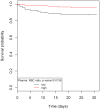Massive Transfusion in Cardiac Surgery: The Impact of Blood Component Ratios on Clinical Outcomes and Survival
- PMID: 28333704
- PMCID: PMC5438286
- DOI: 10.1213/ANE.0000000000001926
Massive Transfusion in Cardiac Surgery: The Impact of Blood Component Ratios on Clinical Outcomes and Survival
Abstract
Background: Cardiac surgery is the most common setting for massive transfusion in medically advanced countries. Studies of massive transfusion after injury suggest that the ratios of administered plasma and platelets (PLT) to red blood cells (RBCs) affect mortality. Data from the Red Cell Storage Duration Study (RECESS), a large randomized trial of the effect of RBC storage duration in patients undergoing complex cardiac surgery, were analyzed retrospectively to investigate the association between blood component ratios used in massively transfused patients and subsequent clinical outcomes.
Methods: Massive transfusion was defined as those who had ≥6 RBC units or ≥8 total blood components. For plasma, high ratio was defined as ≥1 plasma unit:1 RBC unit. For PLT transfusion, high ratio was defined as ≥0.2 PLT doses:1 RBC unit; PLT dose was defined as 1 apheresis PLT or 5 whole blood PLT equivalents. The clinical outcomes analyzed were mortality and the change in the Multiple Organ Dysfunction Score (ΔMODS) comparing the preoperative score with the highest composite score through the earliest of death, discharge, or day 7. Outcomes were compared between patients transfused with high and low ratios. Linear and Cox regression were used to explore relationships between predictors and continuous outcomes and time to event outcomes.
Results: A total of 324 subjects met the definition of massive transfusion. In those receiving high plasma:RBC ratio, the mean (SE) 7- and 28-day ΔMODS was 1.24 (0.45) and 1.26 (0.56) points lower, (P = .007 and P = .024), respectively, than in patients receiving lower ratios. In patients receiving high PLT:RBC ratio, the mean (SE) 7- and 28-day ΔMODS were 1.55 (0.53) and 1.49 (0.65) points lower (P = .004 and P = .022), respectively. Subjects who received low-ratio plasma:RBC transfusion had excess 7-day mortality compared with those who received high ratio (7.2% vs 1.7%, respectively, P = .0318), which remained significant at 28 days (P = .035). The ratio of PLT:RBCs was not associated with differences in mortality.
Conclusions: This analysis found that in complex cardiac surgery patients who received massive transfusion, there was an association between the composition of blood products used and clinical outcomes. Specifically, there was less organ dysfunction in those who received high-ratio transfusions (plasma:RBCs and PLT:RBCs), and lower mortality in those who received high-ratio plasma:RBC transfusions.
Trial registration: ClinicalTrials.gov NCT00991341.
Figures


Comment in
-
Reassessing RECESS: In Pursuit of the Golden Ratio of Hemostatic Components to Red Blood Cells.Anesth Analg. 2017 Jun;124(6):1760-1761. doi: 10.1213/ANE.0000000000002123. Anesth Analg. 2017. PMID: 28525504 No abstract available.
Similar articles
-
Massive Blood Transfusion in Patients with Ruptured Abdominal Aortic Aneurysm.Eur J Vasc Endovasc Surg. 2016 Nov;52(5):597-603. doi: 10.1016/j.ejvs.2016.07.023. Epub 2016 Sep 4. Eur J Vasc Endovasc Surg. 2016. PMID: 27605360
-
Debunking the survival bias myth: characterization of mortality during the initial 24 hours for patients requiring massive transfusion.J Trauma Acute Care Surg. 2012 Aug;73(2):358-64; discussion 364. doi: 10.1097/TA.0b013e31825889ba. J Trauma Acute Care Surg. 2012. PMID: 22846940
-
Increased number of coagulation products in relationship to red blood cell products transfused improves mortality in trauma patients.Transfusion. 2010 Feb;50(2):493-500. doi: 10.1111/j.1537-2995.2009.02414.x. Epub 2009 Oct 5. Transfusion. 2010. PMID: 19804568
-
Platelet to erythrocyte transfusion ratio and mortality in massively transfused trauma patients. A systematic review and meta-analysis.J Trauma Acute Care Surg. 2021 Oct 1;91(4):759-771. doi: 10.1097/TA.0000000000003323. J Trauma Acute Care Surg. 2021. PMID: 34225351
-
Hemostatic resuscitation for massive bleeding: the paradigm of plasma and platelets--a review of the current literature.Transfusion. 2010 Mar;50(3):701-10. doi: 10.1111/j.1537-2995.2009.02458.x. Epub 2009 Nov 19. Transfusion. 2010. PMID: 19929864 Review.
Cited by
-
Impact of Intraoperative Blood Transfusion on Cerebral Injury in Pediatric Patients Undergoing Congenital Septal Heart Defect Surgery.J Clin Med. 2024 Oct 11;13(20):6050. doi: 10.3390/jcm13206050. J Clin Med. 2024. PMID: 39458000 Free PMC article.
-
Tailoring transfusion strategy using thromboelastogram in goal-directed massive transfusion: Impact on transfusion requirements and clinical outcomes.Asian J Transfus Sci. 2024 Jan-Jun;18(1):7-15. doi: 10.4103/ajts.ajts_56_23. Epub 2024 Jun 21. Asian J Transfus Sci. 2024. PMID: 39036674 Free PMC article.
-
Relationship between fresh frozen plasma to packed red blood cell transfusion ratio and mortality in cardiovascular surgery.J Anesth. 2018 Aug;32(4):539-546. doi: 10.1007/s00540-018-2508-6. Epub 2018 May 22. J Anesth. 2018. PMID: 29789931
-
Ratios of Plasma and Platelets to Red Blood Cells in Surgical Patients With Acute Intraoperative Hemorrhage.Anesth Analg. 2020 Aug;131(2):483-493. doi: 10.1213/ANE.0000000000004609. Anesth Analg. 2020. PMID: 31880628 Free PMC article.
-
Association between perioperative plasma transfusion and in-hospital mortality in patients undergoing surgeries without massive transfusion: A nationwide retrospective cohort study.Front Med (Lausanne). 2023 Feb 15;10:1130359. doi: 10.3389/fmed.2023.1130359. eCollection 2023. Front Med (Lausanne). 2023. PMID: 36873874 Free PMC article.
References
-
- Dzik WS, Ziman A, Cohen C, et al. Survival after ultramassive transfusion: a review of 1360 cases. Transfusion. 2016;56:558–563. - PubMed
-
- Jacobs JP, Shahian DM, Prager RL, et al. Introduction to the STS National Database Series: Outcomes Analysis, Quality Improvement, and Patient Safety. The Annals of thoracic surgery. 2015;100:1992–2000. - PubMed
-
- Koch CG, Li L, Duncan AI, et al. Morbidity and mortality risk associated with red blood cell and blood-component transfusion in isolated coronary artery bypass grafting. Crit Care Med. 2006;34:1608–1616. - PubMed
-
- Zatta AJ, McQuilten ZK, Mitra B, et al. Elucidating the clinical characteristics of patients captured using different definitions of massive transfusion. Vox sanguinis. 2014;107:60–70. - PubMed
Publication types
MeSH terms
Associated data
Grants and funding
LinkOut - more resources
Full Text Sources
Other Literature Sources
Medical
Miscellaneous

